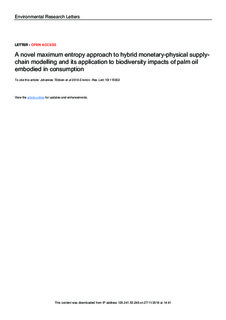| dc.contributor.author | Többen, Johannes Reinhard | |
| dc.contributor.author | Wiebe, Kirsten Svenja | |
| dc.contributor.author | Verones, Francesca | |
| dc.contributor.author | Wood, Richard | |
| dc.contributor.author | Moran, Daniel | |
| dc.date.accessioned | 2019-02-19T13:11:28Z | |
| dc.date.available | 2019-02-19T13:11:28Z | |
| dc.date.created | 2018-11-17T13:29:43Z | |
| dc.date.issued | 2018 | |
| dc.identifier.citation | Environmental Research Letters. 2018, 13 (11), . | nb_NO |
| dc.identifier.issn | 1748-9326 | |
| dc.identifier.uri | http://hdl.handle.net/11250/2586305 | |
| dc.description.abstract | The environmental and social consequences of clearing tropical forests for palm oil and soybean monoculture have been analyzed in a number of studies and are widely recognized. Some initiatives and studies have examined portions of the supply chain from the perspective of individual companies and stages in the supply chain. We complement this work by providing a consistent, detailed, global trade-linked analysis of the four major vegetable oils, connecting land use for production and its biodiversity impact, through global supply chains, to final consumers. To this end, we develop a global model by fully integrating FAO's physical supply-utilization accounts into the environmentally extended multiregional input–output model EXIOBASE. Global supply chains are linked with the life-cycle impact assessment model LC-Impact to assess biodiversity impact of land use via global maps of oil crop cultivation. For the period 2000–2010, we find significant substitution of domestically produced oils with relatively low biodiversity impacts with Indonesian palm oil and Brazilian soybean oil for the major consuming countries, China, Europe and the US. Whereas soybean oil remains the vegetable oil with the largest impact on biodiversity at a global scale, biodiversity footprints of palm oil have grown substantially larger in the period 2000–2010, driven by demand from Europe and China. Our results suggest that demand-side policies focused on specific oils, such as palm oil, might lead to switching oils and unintended shifts of environmental impacts. | nb_NO |
| dc.language.iso | eng | nb_NO |
| dc.publisher | IOP Publishing | nb_NO |
| dc.rights | Navngivelse 4.0 Internasjonal | * |
| dc.rights.uri | http://creativecommons.org/licenses/by/4.0/deed.no | * |
| dc.title | A novel maximum entropy approach to hybrid monetary-physical supply-chain modelling and its application to biodiversity impacts of palm oil embodied in consumption | nb_NO |
| dc.title.alternative | A novel maximum entropy approach to hybrid monetary-physical supply-chain modelling and its application to biodiversity impacts of palm oil embodied in consumption | nb_NO |
| dc.type | Journal article | nb_NO |
| dc.type | Peer reviewed | nb_NO |
| dc.description.version | publishedVersion | nb_NO |
| dc.source.pagenumber | 10 | nb_NO |
| dc.source.volume | 13 | nb_NO |
| dc.source.journal | Environmental Research Letters | nb_NO |
| dc.source.issue | 11 | nb_NO |
| dc.identifier.doi | 10.1088/1748-9326/aae491 | |
| dc.identifier.cristin | 1631676 | |
| dc.description.localcode | © 2018 The Author(s). Published by IOP Publishing Ltd. Original content from this work may be used under the terms of the Creative Commons Attribution 3.0 licence. | nb_NO |
| cristin.unitcode | 194,64,25,0 | |
| cristin.unitname | Institutt for energi- og prosessteknikk | |
| cristin.ispublished | true | |
| cristin.fulltext | original | |
| cristin.qualitycode | 1 | |

